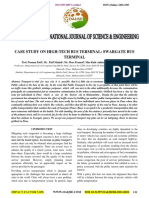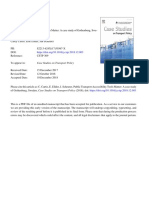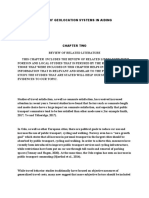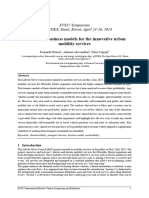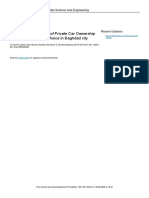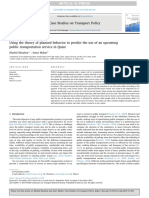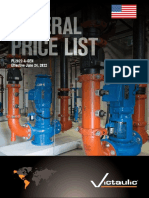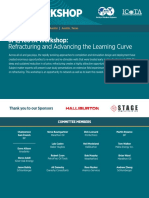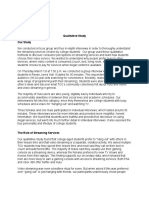The Estimation of Modal Shift Potential
The Estimation of Modal Shift Potential
Uploaded by
Shawon HadyCopyright:
The Estimation of Modal Shift Potential
The Estimation of Modal Shift Potential
Uploaded by
Shawon HadyOriginal Description:
Copyright
Share this document
Did you find this document useful?
Is this content inappropriate?
Copyright:
The Estimation of Modal Shift Potential
The Estimation of Modal Shift Potential
Uploaded by
Shawon HadyCopyright:
Estimation of Modal Shift Potential for
a New Form of Dial-A-Ride Service
Banihan Gunay and Kadir Akgol
Akdeniz University, Turkey
Ingmar Andreasson
Royal Institute of Technology, Sweden
Serdal Terzi
Suleyman Demirel University, Turkey
Abstract
The concept of a dynamic and flexible Intelligent Subscription Bus Service (I-Service) was
developed, and two integrated questionnaires were conducted among the commuters
of a large university campus. To determine travel times to the campus by I-Service, a
digital urban road network map with travel time databases was produced, and software
was developed to calculate optimum routes using these databases. Travel times for
each participant were determined by the shortest travel time principle. The proposed
hypothetical service was introduced to participants, and anticipated advantages for each
participant were reported back to them by means of a second questionnaire to determine
if they would prefer using I-Service. As a result, a 49% modal shift potential from all other
modes in general and a 52% modal shift potential from private car to I-Service were
found.
Keywords: Flexible public transport, optimum route, modal shift, road network map,
dial-a-ride
Introduction
Today, people favor private cars and regard conventional public transport as a last
solution. The primary reason for this is the inconvenience of public transport, including
inappropriate routes, lack of services, lack of stops within walking distance, waiting
at stops (especially in poor weather), lack of information on arrival times, in-vehicle
crowding, shortcomings of payment systems, and excessive stops, all of which vary from
place to place. The inability of conventional public transport to deter people from using
private cars and the increase in citizen demand for private cars cause traffic problems,
and infrastructure investments to eliminate these traffic problems require significant
Journal of Public Transportation, Vol. 19, No. 2, 2016 75
Estimation of Modal Shift Potential for a New Form of Dial-A-Ride Service
expenditures. Traffic jams, which occur as cities become building sites and alternative
roads are inadequate, show that it is necessary to find alternative solutions to traffic
problems. Proposals and services that enable people to favor public transport over
private cars are the strongest of these alternatives.
To solve the transport problems experienced in urban areas in the recent years,
various studies have been conducted in travel demand management, which aims to
supervise demand rather than create additional demand through the construction
of new roads. Travel demand management can be defined as shaping the available
transport infrastructure through small investments that will allow citizens to use it
more efficiently and ensure that journeys will shift to fuller and higher-capacity vehicles
(Ozsoy 2005). In parallel with these objectives, orientation toward flexible transport
services instead of fixed-route transport is among the important issues that will make
the use of public transport more efficient. Flexible transport services have no fixed
routes and no specified boarding/alighting points and times and are carried out by
vehicles with a capacity of 4–20 people (Josselin et al. 2009). They aim to implement
service that provides the best balance between unit cost and service quality and that
provide an opportunity of offering comfort similar to the comfort of a private car
(Hatipoglu et al. 2007; Akgol et al. 2014).
A flexible urban mode of transport to compete with the use of private cars should not
be considered a competitor of, but complementary to, conventional public transport
and should enhance the attractiveness of public transport. This mode is more flexible
in terms of route and time than conventional public transport (Finn 2012) and includes
on-demand transport, shared taxi, service vehicles of establishments, vehicle sharing,
and group transport for the mobility impaired. In such systems, routes are determined
according to incoming demand and shortest route optimization. The type of vehicle
may vary by density and demand, and the method of payment may differ depending
on demand by passengers. Reservations to use the service are made via Internet or
telephone (Brake et al. 2007). Flexible public transport also is a comfortable transport
option for those who do not own a private car or who are unable to drive or own a
private car and is a good travel alternative for those who have difficulty using available
public transport. It is a strong alternative to the use of private cars and encourages
public transport (Hatipoglu et al. 2007).
Mulley et al. (2012) emphasized the necessity of encouraging the application of
flexible public transport services and proposed a number of solutions to overcome
the difficulties faced by these services in Australia, Europe and the U.S. Early regular
applications of on-demand services were launched in the U.S. in the early 1970s.
Currently being implemented in many countries around the world, particularly England,
these services are spreading rapidly. Today, in the U.S. alone, there are about 23,000
companies and more than 370,000 vehicles serving in this mode of transport (Hatipoglu
et al. 2007). Many local governments and public transport operators in England and
Ireland use flexible transport service for social improvement, especially in areas in which
public transport is difficult (Kamruzzaman et al. 2011); the service generally has been
implemented in rural areas in terms of design and operation. In Switzerland, demand-
responsive PubliCar minibuses run in connection with conventional public transport in
Journal of Public Transportation, Vol. 19, No. 2, 2016 76
Estimation of Modal Shift Potential for a New Form of Dial-A-Ride Service
a completely flexible way; they use reservations and serve rural areas and small towns
with populations of 5,000–10,000 people in 32 regions. TaxiTubs serves on demand in
the Nord-Pas-de Calais region in the northeast of France with a main goal of feeding
the bus lines. Anruf Sammel Taxi (AST) runs in some regions of Germany (Nelson et al.
2010). With use in appropriate places at appropriate times and with an appropriate plan
after development through research and studies, flexible transport has the potential for
becoming a service of crucial importance in the future (Laws et al. 2009).
For passengers, factors such as cost, capacity, time, flexibility, and reliability are
important for comparing different services. Considering these factors, passenger
demand could be shifted from conventional public transport to flexible transport
services (Vedagiri and Arasan 2009). Recent developments in communication
technology have helped to alleviate transportation problems by enhancing alternative
transport modes (Chow 2014), such as through vehicle position and customer demand
determinations in real time, thus making flexible public transport more attractive
(Hosni et al. 2014; Jung and Jayakrishnan 2011; Agatz et al. 2011). Dial-a-ride is one of
these flexible public transport types.
Psaraftis (1980), Horn (2002), and Sayarshad and Chow (2015) studied dynamism in dial-
a-ride using the “traveling salesman” problem for route selection. In this paper, however,
we used the Dijkstra algorithm, as is demonstrated later. Other researchers who used
the Dijkstra algorithm for similar problems include Gebeyehu and Takano (2008), Moloo
et al. (2013), and Nykl et al. (2014). In this paper, the Dijkstra algorithm was used due to
its convenience and simplicity for various programming and computation requirements,
such as the capability of evaluating rising demand and instant acceptance/rejection.
According to Ramazzotti and Lios (2009), public transport authorities can support
decision-makers with specific data and surveys to determine if the service is sustainable
from different points of view. Hauser and Wisinewski (1982) studied the future potential
of dial-a-ride transportation through questionnaires with no particular reference to
modal shift as a result of increased use of the system.
In this paper, we generated the concept of Intelligent Subscription Bus Service (I-Service)
and estimated the impact of this service on the rate of preference; in other words, we
investigated whether people would favor available modes of transport over a proposed
service with an intelligent and flexible vehicle fleet. I-Service is a dynamic and flexible
transport service that determines its route according to incoming instant demand. This
service can receive reservations at the last moment via Internet or telephone and can
offer alternative payment possibilities. This new concept includes an algorithm capable
of accepting or rejecting real-time demand (with flexible routes) as opposed to existing
systems (especially the subscription buses currently in use in Turkey). These (existing)
services operate on a monthly or annual subscription basis; hence, they charge more
compared to ordinary public transport services. In addition, they operate only on fixed
routes, giving rise to considerably long journey times. I-Service, on the other hand, is
conceptualized on a “pay-as-you-go” basis. By optimizing between demand and journey
time, overall travel times are kept to a minimum. When I-Service is compared with
reserved taxis, the biggest difference is fares, since the seating capacities of taxis are
Journal of Public Transportation, Vol. 19, No. 2, 2016 77
Estimation of Modal Shift Potential for a New Form of Dial-A-Ride Service
much smaller than the I-Service vehicles proposed. Fare cost, therefore, is one of the
most important factors affecting demand for such services.
Material and Method
Questionnaire I
A survey was conducted with 606 people on the main campus of Akdeniz University
in Antalya, Turkey, to determine the current travel characteristics of passengers who
regularly commuted to and from the campus. Using respondent address information,
digital maps that showed the need for transport to the campus within different time
periods were determined. The optimum number of vehicles required for users of this
service, the travel kilometers of the vehicles, and the new transport characteristics of
the passengers were determined by modeling the I-Service. Finally, the participants
in the survey were individually notified of the information on the new transport
characteristics via their email addresses and asked if they would prefer to use the
service. In this way, the shift likely to occur in the mode of transport was estimated.
The A-Service Model
A university campus was selected as the pilot area, and possible users of the system
were students, academic staff, and other staff. Participants were asked to provide
personal information (e.g., occupation, age, gender, health status) and residence
location; the importance they attached to comfort; whether they possessed their
own car; their existing travel mode; travel times, days, and hours they commuted;
total waiting and travel times of their use of available public transport; and their email
addresses. Participant responses were grouped according to their times of commuting
to and from the campus, and the groups were geocoded by means of Geographic
Information Systems (GIS) according to the address information they provided.
This study aimed to determine the service duration of I-Service during the day and data
about the travel times of potential passengers by modeling the concept of I-Service
vehicles. For this purpose, information on the speeds that could be performed on the
urban road network of Antalya in different time periods was collected. To do this, 10
global positioning system (GPS) devices were placed in approximately 100 vehicles
for four months; the GPS devices were monitored online, and the data received were
recorded via a central computer. In this way, information on the speeds that could be
performed at different times regarding each road link was obtained, and 34 speed maps
were created.
The model developed for I-Service aimed to carry as many subscribers as possible at
minimum total journey time since time was chosen as the most important parameter.
That is, travel time was prevented from exceeding a specific range by increasing the
number of vehicles when necessary. Dijkstra’s algorithm, which calculates the shortest
route from a source node to all other points on a network, was used in the model (Taha
2007). For the model, software was developed in Java to compute the shortest routes
between given sets of origin and destination points (Figure 1).
Journal of Public Transportation, Vol. 19, No. 2, 2016 78
Estimation of Modal Shift Potential for a New Form of Dial-A-Ride Service
FIGURE 1.
User interface of
software created
in Java
For route calculations, the link travel times data gathered earlier were used, as shown in
Table 1.
TABLE 1. Link Travel Time Demand
Sample of Link Travel Time 1 A1 B1
Database
2 A2 B2
X = Coefficient of resistance for demand (X=0.001).
In quickest route calculations, coefficient encourages
I-Service vehicle to use this link where there is demand;
achieved by intentionally reducing travel times on
these links.
Ai = Travel time for link i
Bi = Number demanded for link i
In this case, the link travel times were calculated (based on the Dijkstra algorithm) by
the following:
If a call (demand) exists; (B1 ≠ 0). Travel time for this link (Link 1) =
A1 / (B1+X) (1)
If a call (demand) does not exist, (B2 = 0). Travel time for this link (Link 2) =
A2 / X (2)
Journal of Public Transportation, Vol. 19, No. 2, 2016 79
Estimation of Modal Shift Potential for a New Form of Dial-A-Ride Service
After setting up the model, data on the number of people boarding and the identity
of the links onto which they boarded were entered into the software database. When
the shortest route was calculated according to the Dijkstra algorithm, the vehicle
was assigned to the links with service demand. In this way, results were obtained
for such questions as how many people were carried by how many vehicles, how
many kilometers were traveled in total, and how the travel times turned out for each
respondent for “a typical day.” Based on the results produced by the software, it was
determined that 64 vehicles would be required if all respondents used this service for
commuting to and from campus. In this case, a distance of 5,300 kilometres (3,293
miles), on average, was traveled per day.
Cost
To estimate the single fare for a one-way journey by I-Service, the monthly total cost
was computed. As a result of a number of calculations, the details of which are outside
the scope of this paper, this figure was determine to be a total of TL 135,500 ($52,613).
The number of people using the service also was calculated to determine the travel fare
per capita for this service. For this purpose, data from Questionnaire I on the number
of possible users of the service vehicle were used. Responses to “If you had a chance
to choose for commuting to and from the campus among the modes of transport
classified as public transport, service vehicle, automobile, motorcycle, bicycle, and
pedestrian, what would be your order of preference?” from Questionnaire I determined
the rates of preference of academic staff, other staff, and students. In total, 100% of
those who preferred service vehicles in the first place and 50% of those who preferred
them in the second place were calculated, and the percentages of possible users were
determined. Accordingly, 42.7% of academic staff, 66.4% of administrative staff, and 30%
of students were possible users of the service. The number of commuters to and from
the campus were 2,081 academic staff, 3,294 other staff, and 37,379 students (obtained
from the university). Thus, it was determined that I-Service would have 888 + 2,188 +
11,196 = 14,272 potential users at Akdeniz University. As this figure is higher than the
total passenger capacity, the travel cost would depend only on the rate of occupancy
of the vehicles. The correlation between the travel costs per capita for I-Service vehicles
and the total rates of occupancy of the vehicles was examined. The service price would
be TL 2.50 ($1), and a profit of TL 0.50 ($0.20) per capita would be made in the event
that the rate of occupancy was around 50%.
Questionnaire II
A map showing the travel times by I-Service, obtained from the route travel times
data, was used (Figure 2) to assist the respondents with Questionnaire II. A total of 377
people participated in the second survey. The travel times and travel costs for I-Service
were determined by modeling the I-Service. The current transport characteristics and
the new transport characteristics that would occur if the respondent used I-Service,
general information on I-Service, and a questionnaire form (Questionnaire II) containing
two questions were emailed to the respondents of Questionnaire I (Table 2).
Journal of Public Transportation, Vol. 19, No. 2, 2016 80
Estimation of Modal Shift Potential for a New Form of Dial-A-Ride Service
FIGURE 2. Map showing travel times if I-Service used
TABLE 2. Question Response
Questionnaire II Yes, every weekday (…)
1. Would you prefer I-Service? Sometimes, a few days (…)
No (…)
If your answer is No, why? (…)
Yes (…)
2. Do you find the projected price of I-Service appropriate?
No (…)
If your answer is No, how much would you pay for this service? (…)
Summary of Surveys
In summary, the first survey, 606 people were asked about their age, gender, occupation,
email address, residential address, existing modes of commuting transport, time spent
for commuting, travel schedules, satisfaction levels, desired modes of commuting
transport, etc. Based on the address and travel schedule information provided, a
hypothetical model was developed for these particular individuals to determine if
the proposed I-Service would offer shorter travel times between the same origins
Journal of Public Transportation, Vol. 19, No. 2, 2016 81
Estimation of Modal Shift Potential for a New Form of Dial-A-Ride Service
and destinations at competitive costs. Also in the first survey, we determined the
number of people who would use an existing subscription bus service if introduced.
To be conservative, in the model, this demand was reduced by 50% to be able to
accommodate potential survey uncertainties. After calculating one-way fares using the
model, a second survey was conducted with these 606 respondents, and 560 people
expressed whether they would use the proposed I-Service at a particular fare and a
commuting travel time between their origins and destinations.
Findings
According to the results obtained from Questionnaire I, the distribution of the
participants was academic staff (40%), other staff (24%), and students (36%). When
the distribution was examined by modes of transport, automobile (48%) was the most
preferred mode (Table 3). When the results of both surveys were analyzed, it was found
that automobile users had the largest potential to change mode, followed by public
transport users; 44% of public transport users and 34% of automobile users continued
to favor the automobile.
TABLE 3. Mode Distribution
Participant Existing Automobile 48%
Mode Choice
Public transport 26%
Pedestrian 18%
Bicycle 5%
Motorcycle 3%
According to the travel maps with time dimensions (e.g., Figure 3), it can be seen that
the need for transport to the campus is denser during morning hours.
Journal of Public Transportation, Vol. 19, No. 2, 2016 82
Estimation of Modal Shift Potential for a New Form of Dial-A-Ride Service
FIGURE 3. Example of demand for transport to campus in different time slices and arbitrarily-selected routes
for demonstration purposes
Journal of Public Transportation, Vol. 19, No. 2, 2016 83
Estimation of Modal Shift Potential for a New Form of Dial-A-Ride Service
As a result of the data entered onto the map, the speeds of traffic in different links within
the desired time zones can be seen. A sample of these maps is provided in Figure 4.
FIGURE 4. Sample of GIS map for speed range
In total, 20% of the public transport users and 26% of the automobile users preferred
the new service. Reasons why the service was not preferred are presented in Table 4. It
was determined that there would be a 49% modal shift in total (from 48% to 23% mode
share), which shows the effect on the shift between modes. The service would lead to
a 52% reduction in the use of automobiles, a 59% reduction in public transport, and a
26% reduction in pedestrians.
TABLE 4. Reason Percent
Reasons Why I-Service Not Familial reasons 10%
Preferred Among Participants
Comfort 1%
Need for a private car 12%
Health 16%
Fare 23%
Proximity 25%
Time 13%
Journal of Public Transportation, Vol. 19, No. 2, 2016 84
Estimation of Modal Shift Potential for a New Form of Dial-A-Ride Service
When the effect of the distribution of occupation on the modal shift caused by the
I-Service for Akdeniz University campus was examined, it was seen that 51% of academic
staff, 71% of other staff, and 44% of students shifted their mode.
Finally, the estimated distributions of the modes before and after the I-Service were
compared. As seen in Table 5, the rate of use of automobiles was 48% before the survey,
which dropped to 23% (second) after the introduction of I-Service, which ranked first
(49%). This indicates that this alternative transport service would be an essential step
towards tackling traffic problems.
TABLE 5. Mode of Participant Distribution Participant Distribution
Comparison of Existing Mode Transport before I-Service after I-Service
and I-Service I-Service – 49%
Automobile 48% 23%
Public transport 26% 11%
Pedestrian 18% 13%
Bicycle 5% 3%
Motorcycle 3% 1%
These rates indicate that I-Service has a high potential for being preferred. Although
these auto trips to/from the university are but a small percentage of total trips in the
area and the impact on traffic reduction would be minimal, putting similar services
into practice in places such as universities, factories, shopping centers, and airports
could impact overall traffic. Also, the scheme may have positive implications on campus
parking, where there are currently serious parking issues. All of these potentials will be
the subject of further research.
Private car users would financially save 23% if using I-Service but would experience 16%
longer travel times. Public transport users, however, would pay 45% more and shorten
their travel times by 64%. This shows that the I-Service, as presumed, would be an
alternative that is quicker than ordinary public transport and cheaper than private car
use.
A sensitivity analysis was carried out on the reliability of the responses to the
questionnaire about the willingness to use the I-Service. The results showed that
the most effective factors in user choice are the new travel times and fare costs (by
85–95%); age, gender, occupation, and satisfaction level with existing mode of transport
contributed 10–40%. These figures imply that the acceptability potential of the I-Service
in application areas other than the study area is likely to be similar.
Discussion and Conclusion
Today, new modes of transport are being introduced to reduce traffic density and
encourage people to use public transport instead of automobiles. Seeking private car-
based solutions does not solve the problem but merely defers it to some future time.
Conventional public transport remains insufficient for making people switch from their
private cars to public transport. Hence, more innovative modes of transport to reduce
Journal of Public Transportation, Vol. 19, No. 2, 2016 85
Estimation of Modal Shift Potential for a New Form of Dial-A-Ride Service
the use of private cars will contribute towards easing the traffic problem. An intelligent
transport service with a reservation system that provides a flexible and dynamic public
service based on minimum travel times was introduced and modeled in this study.
The new I-Service was designed to provide an economical service that offers comfort
close to that of a private car, and its effect on the mode of transport was investigated.
Information from 606 participants was obtained through two questionnaires conducted
on the Internet within the campus of Akdeniz University. The study estimated the
required number of vehicles and drivers if respondents were to use the service.
Optimum routes, travel times, and kilometers for these routes were determined, as were
one-way fares and travel times for each passenger. A total of 49% of the respondents to
Questionnaire II stated that they would use this service at a 2.5 TL ($1) single fare.
Examining the reasons why 51% of participants did not prefer the I-Service, many factors
were influential. The most common reasons included living near the campus, health,
and fare. Pedestrians and bicycle users did not prefer this service because they lived
near the campus; automobile users did not prefer it because they use their automobile
for more than commuting to and from campus; and the public transport users did
not prefer it because they thought the fare was high. There was estimated to be a 52%
modal shift from the use of automobiles to the use of I-Service; it would provide a more
comfortable service than conventional public transport, which would lead to a 59%
shift from public transport and a 26% shift from pedestrians. When automobile and
motorcycle users were evaluated collectively, the mode shift rose from 52% to 54%. In
total, 51% of academic staff, 70% of other staff, and 44% of students contributed to the
mode shift caused by I-Service. These rates indicate that I-Service has a high potential
for the future and deserves further and special research attention.
Acknowledgments
This study was conducted under a research project titled “An Intelligent Subscription
Bus Service Concept and the Estimate of Useful Effects on Modal Shift in a Transport
System: Computer Modelling in a Pilot Region” (112M019), which was supported by the
Turkish Scientific and Technological Research Institute (TUBITAK). The authors would
like to thank TUBITAK for this support.
References
Agatz, N. A. H., A. L. Erera, M. W. P. Savelsbergh, and X. Wang. 2011. “Dynamic Ride-
Sharing: A Simulation Study in Metro Atlanta.” Transportation Research Part B:
Methodological, 45(9): 1450-1464.
Akgol, K., M. M. Aydin, O. Asilkan, and B. Gunay. 2014. “Prediction of Modal Shift
Using Artificial Neural Networks.” Journal of the Association for Information
Communication Technologies, 3(3): 223-229.
Brake, J., C. Mulley, J. D. Nelson, and S. Wright. 2007. Key Lessons Learned from Recent
Experience with Flexible Transport Services.” Transport Policy, 14(6): 458-466.
Journal of Public Transportation, Vol. 19, No. 2, 2016 86
Estimation of Modal Shift Potential for a New Form of Dial-A-Ride Service
Chow, J. Y. J. 2014. Policy Analysis of Third Party Electronic Coupons for Public Transit
Fares.” Transportation Research Part A: Policy and Practice, 66(1): 238-250.
Finn, B. 2012. “Towards Large-Scale Flexible Transport Services: A Practical Perspective
from the Domain of Paratransit.” Research in Transportation Business &
Management, 3: 39-49.
Gebeyehu, M., and S.-e. Takano. 2008. “Demand Responsive Route Design: GIS
Application to Link Downtowns with Expansion Areas.” Journal of Public
Transportation, 11(1): 3.
Hatipoglu, S., E. A. Ozturk, and M. K. Cubuk. 2007. “Demand Responsive Transit System
in Urban Transportation: An Information System Design.” JESTECH Engineering
Science and Technology an International Journal, 10(4): 239-248.
Hauser, J. R., and K. J. Wisniewski. 1982. “Application, Predictive Test, and Strategy
Implications for a Dynamic Model of Consumer Response.” Marketing Science, 1(2):
143-179.
Horn, M. E. T. 2002. “Fleet Scheduling and Dispatching for Demand-Responsive
Passenger Services.” Transportation Research Part C: Emerging Technologies, 10(1):
35-63.
Hosni, H., J. Naoum-Sawaya, and H. Artail. 2014. “The Shared-Taxi Problem: Formulation
and Solution Methods.” Transportation Research Part B: Methodological:, 70: 303-
318.
Josselin, D., C. Lang, and N. Marilleau. 2009. “Modelling Dynamic Demand Responsive
Transport Using an Agent Based Spatial Representation.” ECCS ‘09, European
Conference on Complex Systems, University of Warwick, United Kingdom.
Jung, J., and R. Jayakrishnan. 2011. “High-Coverage Point-to-Point Transit: Study of Path-
Based Vehicle Routing through Multiple Hubs.” Transportation Research Record,
2287: 78-87.
Kamruzzaman, M., J. Hine, B. Gunay, and N. Blair. 2011. “Using GIS to Visualise and
Evaluate Student Travel Behaviour.” Journal of Transport Geography, 19(1): 13-32.
Laws, R., M. P. Enoch, S. G. Ison, and S. Potter. 2009. “Demand Responsive Transport: A
Review of Schemes in England and Wales.” Journal of Public Transportation, 12(1):
19-37.
Moloo, R. K., H. Moonosawmy, and V. Ramanah. 2013. “An Optimal Route Planner
Framework for Mauritius based on Real-Time Constraints.” 2013 International
Conference on ICT for Smart Society (ICISS): Think Ecosystem Act Convergence: 231-
236.
Mulley, C., J. Nelson, R. Teal, S. Wright, and R. Daniels. 2012. “Barriers to Implementing
Flexible Transport Services: An International Comparison of the Experiences in
Australia, Europe and USA.” Research in Transportation Business & Management, 3:
3-11.
Journal of Public Transportation, Vol. 19, No. 2, 2016 87
Estimation of Modal Shift Potential for a New Form of Dial-A-Ride Service
Nelson, J. D., S. Wright, B. Masson, G. Ambrosino, and A. Naniopoulos. 2010. “Recent
Developments in Flexible Transport Services.” Research in Transportation
Economics, 29(1): 243-248.
Nykl, J., M. Jakob, and J. Hrncir. 2014. “Advanced Public Transport Network Analyser.”
In Schaub, T., G. Friedrich, and B. O’Sullivan (eds.), 21st European Conference on
Artificial Intelligence. Amsterdam: IOS Press.
Ozsoy, M. 2005. “A New Model for Para Transit System (Dolmus) in Ankara: Case Study
Cayyolu.” Master’s thesis, Gazi University.
Psaraftis, H. N. 1980. “A Dynamic Programming Solution to the Single Vehicle Many-
to-Many Immediate Request Dial-a-Ride Problem.” Transportation Science, 14(2):
130-154.
Ramazzotti, D. and A. Lois. 2009. “Sustainable Flexible Transport Services: A Solution
against Social Exclusion.” Fourth International Conference on Sustainable
Development and Planning, May 13–15, Cyprus.
Sayarshad, H. R., and J. Y. J. Chow. 2015. “A Scalable Non-Myopic Dynamic Dial-a-Ride
and Pricing Problem.” Transportation Research Part B: Methodological, 81(2): 539-
554.
Taha, H. A. 2007. Operations Research: An Introduction, 9th ed. New York: Pearson.
Vedagiri, P., and V. T. Arasan. 2009. “Modelling Modal Shift Due to the Enhanced Level of
Bus Service.” Transport, 24(2): 121-128.
About the Authors
Banihan Gunay (banihangunay@akdeniz.edu.tr) is a Professor in the Department
of Civil Engineering at Akdeniz University in Antalya, Turkey. He holds a Ph.D. from the
University of Newcastle Upon Tyne, UK, and specializes in transportation and traffic
engineering and operations.
Kadir Akgol (kadirakgol@akdeniz.edu.tr) is a Research Assistant and Ph.D. student
in the Department of Civil Engineering at Akdeniz University, from which he earned a
master’s degree in Civil Engineering (Transportation).
Ingmar Andreasson (ingmar@logistikcentrum.se) is a Professor Emeritus at the
Center for Traffic Research at the Royal Institute of Technology in Stockholm, Sweden,
from which he earned a Ph.D. in Computer Simulation Methods and an M.Sc. in
Applied Physics.
Serdal Terzi (serdalterzi@sdu.edu.tr) is a Professor in the Department of Civil
Engineering at Suleyman Demirel University in Isparta, Turkey, from which he earned
a Ph.D. in Civil Engineering (Transportation) and an M.Sc. in Construction Education
(Transportation).
Journal of Public Transportation, Vol. 19, No. 2, 2016 88
You might also like
- From Mobility to Accessibility: Transforming Urban Transportation and Land-Use PlanningFrom EverandFrom Mobility to Accessibility: Transforming Urban Transportation and Land-Use PlanningNo ratings yet
- API 609 StandarDocument1 pageAPI 609 StandarJavier Barrera0% (4)
- A Simulation-Optimization Model For Analyzing A Demand Responsive Transit System For Last-Mile Transportation - A - Torres - OtavoDocument8 pagesA Simulation-Optimization Model For Analyzing A Demand Responsive Transit System For Last-Mile Transportation - A - Torres - OtavoAlexis MinaNo ratings yet
- Shared Clean Mobility Operations For First-Mile AnDocument14 pagesShared Clean Mobility Operations For First-Mile AnsarmaNo ratings yet
- A Demand Responsive Public Transport For A Spatially Scattered PopulationDocument11 pagesA Demand Responsive Public Transport For A Spatially Scattered PopulationKumaresvaranNo ratings yet
- Sochor Et Al 2016 Trying Out Mobility As A Service Experiences From A Field Trial and Implications For UnderstandingDocument8 pagesSochor Et Al 2016 Trying Out Mobility As A Service Experiences From A Field Trial and Implications For Understanding欧宇洋No ratings yet
- Accessibility of Anbessa City Bus Service: Analysis of Stakeholders Opinions in Addis Ababa, EthiopiaDocument11 pagesAccessibility of Anbessa City Bus Service: Analysis of Stakeholders Opinions in Addis Ababa, Ethiopiamelat bizuNo ratings yet
- Accessibility of Anbessa City Bus Service in Addis Ababa, Ethiopia: An Analysis of Stakeholder'S OpinionsDocument20 pagesAccessibility of Anbessa City Bus Service in Addis Ababa, Ethiopia: An Analysis of Stakeholder'S OpinionsErmias MesfinNo ratings yet
- PRROPOSSALDocument46 pagesPRROPOSSALtemesgenNo ratings yet
- A Critical Review of New Mobility ServicesDocument10 pagesA Critical Review of New Mobility Services欧宇洋No ratings yet
- 1.1 Background of The Study: Chapter OneDocument90 pages1.1 Background of The Study: Chapter Onegodislove1111No ratings yet
- RoadSpaceReAllocation (Gonzalez-Guzman Robuste 2011)Document10 pagesRoadSpaceReAllocation (Gonzalez-Guzman Robuste 2011)Juan David Gonzalez AgudeloNo ratings yet
- Case Study On High-Tech Bus Terminal: Swargate Bus Terminal: Impact Factor 5.856Document9 pagesCase Study On High-Tech Bus Terminal: Swargate Bus Terminal: Impact Factor 5.856Nikunj DwivediNo ratings yet
- Multimodal Pricing and Optimal Design Od Urban Public TrasnportDocument22 pagesMultimodal Pricing and Optimal Design Od Urban Public TrasnportMarta Martinica MišićNo ratings yet
- Comparative Analysis of Modal Distribution in Abia State, NigeriaDocument20 pagesComparative Analysis of Modal Distribution in Abia State, NigeriaumunakweNo ratings yet
- Accepted Manuscript: Case Studies On Transport PolicyDocument28 pagesAccepted Manuscript: Case Studies On Transport PolicyJorge OchoaNo ratings yet
- Analysis of Mode Choice Affects From The Introduction of Doha Metro Using Machine Learning and Statistical Analysis (2023)Document16 pagesAnalysis of Mode Choice Affects From The Introduction of Doha Metro Using Machine Learning and Statistical Analysis (2023)andini arumNo ratings yet
- The Journey of Demand Responsive Transportation ToDocument6 pagesThe Journey of Demand Responsive Transportation ToDoruk CoşkunNo ratings yet
- 1 s2.0 S1877042813045655 Main PDFDocument10 pages1 s2.0 S1877042813045655 Main PDFSHERLY OKTAFIANo ratings yet
- A Methodology For Feasibility Analysis of Demand-Responsive Transit ServicesDocument11 pagesA Methodology For Feasibility Analysis of Demand-Responsive Transit ServicesSoumia SaouliNo ratings yet
- Cafae Imrad Format Rev3Document21 pagesCafae Imrad Format Rev3JEAN MARRICE DUNTARNo ratings yet
- Bus Transit Service Planning and Operations in A Competitive EnvironmentDocument27 pagesBus Transit Service Planning and Operations in A Competitive EnvironmentRohit SahaNo ratings yet
- LR 7Document8 pagesLR 7Shivangi PatelNo ratings yet
- Article An Empirical Study of Consumers' Intention To Use Ride-Sharing Services Yu WangDocument19 pagesArticle An Empirical Study of Consumers' Intention To Use Ride-Sharing Services Yu WangSajesh SinghNo ratings yet
- Research Article: Shared Autonomous Vehicles Effect On Vehicle-Km Traveled and Average Trip DurationDocument11 pagesResearch Article: Shared Autonomous Vehicles Effect On Vehicle-Km Traveled and Average Trip DurationabkhaledNo ratings yet
- Optimization of Carsharing Fleet Size To Maximize The Number of Clients ServedDocument10 pagesOptimization of Carsharing Fleet Size To Maximize The Number of Clients Served黄昊No ratings yet
- Intermodality - Key To A More Efficient Urban Transport System?Document11 pagesIntermodality - Key To A More Efficient Urban Transport System?Irina MihălcescuNo ratings yet
- 5TH International Conference On Advances in MechanicalDocument4 pages5TH International Conference On Advances in Mechanicalxyric porteNo ratings yet
- Chapter 2 DraftDocument6 pagesChapter 2 Draftneggywapp11738No ratings yet
- CVEN3031: PROJECT#2 - Literature Review: Hong-Sanh Hua Z5076315 UNSWDocument5 pagesCVEN3031: PROJECT#2 - Literature Review: Hong-Sanh Hua Z5076315 UNSWHong J HuwuaNo ratings yet
- Implementing Mobility As A Service: Challenges in Integrating User, Commercial, and Societal PerspectivesDocument9 pagesImplementing Mobility As A Service: Challenges in Integrating User, Commercial, and Societal Perspectiveslina paola jimenez quevedoNo ratings yet
- Valuing Crowding in Public Transport Implications For Costbenefit AnalysisDocument21 pagesValuing Crowding in Public Transport Implications For Costbenefit AnalysisDiego GaldinoNo ratings yet
- 1 s2.0 S2210539519301002 MainDocument12 pages1 s2.0 S2210539519301002 Mainhuma.aaltoNo ratings yet
- Public Transportation in CitiesDocument7 pagesPublic Transportation in Citiesfrancislaban11No ratings yet
- Civitas Capital Insight Making Public Transport Work Better For EveryoneDocument10 pagesCivitas Capital Insight Making Public Transport Work Better For EveryonepitbullNo ratings yet
- PUBLIC TRANSPORT DELIVERY SYSTEM PROJECT PROPOSAL-1.BoysDocument14 pagesPUBLIC TRANSPORT DELIVERY SYSTEM PROJECT PROPOSAL-1.BoysTakunda MachingautaNo ratings yet
- Commuters' Perceptions of Public Transport Service in South AfricaDocument13 pagesCommuters' Perceptions of Public Transport Service in South AfricaCentre of Excellence for Scientific & Research Journalism, COES&RJ-JLLCNo ratings yet
- Determinants of Passengers Satisfaction in The Public Transport Services: The Case of Dawuro Zone Bus Station, Southern EthiopiaDocument13 pagesDeterminants of Passengers Satisfaction in The Public Transport Services: The Case of Dawuro Zone Bus Station, Southern EthiopiaEndalk BekeleNo ratings yet
- Commuter Preferences For A First Mile Last Mi 2023 Transportation Research PDocument23 pagesCommuter Preferences For A First Mile Last Mi 2023 Transportation Research PJose Luis Moreno GomezNo ratings yet
- EVS37 OrtenziDocument13 pagesEVS37 OrtenziFernando OrtenziNo ratings yet
- Chapter 2 CYTED BookDocument15 pagesChapter 2 CYTED BookJuan PampaNo ratings yet
- Sustainability 13 03424 v3Document16 pagesSustainability 13 03424 v3Rasyid MalikNo ratings yet
- 1 s2.0 S2210670721001323 MainDocument9 pages1 s2.0 S2210670721001323 MainAnkit SinghNo ratings yet
- Transportation Demand Management in A Deprived Territory: A Case Study in The North of FranceDocument12 pagesTransportation Demand Management in A Deprived Territory: A Case Study in The North of FranceBrayan MendezNo ratings yet
- Using Haptics As An Alternative To Visual Map Interfaces For Public Transport Information SystemsDocument13 pagesUsing Haptics As An Alternative To Visual Map Interfaces For Public Transport Information SystemsUbiquitous Computing and Communication JournalNo ratings yet
- Sky Bus Transit SystemDocument20 pagesSky Bus Transit SystembevinthotsNo ratings yet
- SUMMARYDocument21 pagesSUMMARYSyed SyedamirulNo ratings yet
- MageeanDocument16 pagesMageeanKerimcanNo ratings yet
- Lecture 9 - 22Document7 pagesLecture 9 - 22Hussein OmranNo ratings yet
- FOREIGN and LOCAL LITERATUREDocument2 pagesFOREIGN and LOCAL LITERATURECire MalasmasNo ratings yet
- I. Background of The StudyDocument19 pagesI. Background of The StudyKrizsel ContrerasNo ratings yet
- Paper 2 PDFDocument12 pagesPaper 2 PDFsebastianNo ratings yet
- Mobility-On-Demand: An Empirical Study of Internet-Based Ride-Hailing Adoption Factors, Travel Characteristics and Mode Substitution EffectsDocument43 pagesMobility-On-Demand: An Empirical Study of Internet-Based Ride-Hailing Adoption Factors, Travel Characteristics and Mode Substitution EffectsDruNo ratings yet
- 02+ ARDA Publication 798361Document8 pages02+ ARDA Publication 798361Khushi MathurNo ratings yet
- Development of Urban Transportation System Based On Bus Rapid TransitDocument10 pagesDevelopment of Urban Transportation System Based On Bus Rapid TransitIEREKPRESSNo ratings yet
- QatarDocument8 pagesQatarMinh AnhNo ratings yet
- Eng 04 00113Document12 pagesEng 04 00113Umair HasanNo ratings yet
- 5 PDFDocument7 pages5 PDFSathya VeerappanNo ratings yet
- A Matching Algorithm UBERDocument14 pagesA Matching Algorithm UBERAlanNo ratings yet
- Automated Fare Collection System & Urban Public Transportation: An Economic & Management Approach To Urban Transit SystemsFrom EverandAutomated Fare Collection System & Urban Public Transportation: An Economic & Management Approach To Urban Transit SystemsNo ratings yet
- The Future of Transportation: Innovations in Mobility and SustainabilityFrom EverandThe Future of Transportation: Innovations in Mobility and SustainabilityRating: 1 out of 5 stars1/5 (1)
- Construction Products Directive (CPD) 89106EECDocument64 pagesConstruction Products Directive (CPD) 89106EECDraganNo ratings yet
- Feel Ind. Engineering Co., Ltd. Fine Equipment (I) Pvt. Ltd. Feel Machine Co., Ltd. Feeleng America Inc. Feeleng Latin AmericaDocument22 pagesFeel Ind. Engineering Co., Ltd. Fine Equipment (I) Pvt. Ltd. Feel Machine Co., Ltd. Feeleng America Inc. Feeleng Latin Americapt. npm cabang kendariNo ratings yet
- Contoh Case Study Log PenforDocument32 pagesContoh Case Study Log PenforLuffy01No ratings yet
- Shrink Tech SleeveDocument18 pagesShrink Tech Sleevejames<XIIINo ratings yet
- Control Loop Response To Setpoint Change With PID ControlDocument3 pagesControl Loop Response To Setpoint Change With PID ControlwenoNo ratings yet
- Catalogo Victaulic Pl2022 A GenDocument433 pagesCatalogo Victaulic Pl2022 A GenMohanaNo ratings yet
- ACH-70X-36H-F DrawingDocument1 pageACH-70X-36H-F DrawingDamVent DamVentNo ratings yet
- Sandisk 09132017 SanDisk COM-AUTO-INDUST DISTI LIN-1145140 PDFDocument5 pagesSandisk 09132017 SanDisk COM-AUTO-INDUST DISTI LIN-1145140 PDFKelvin LimNo ratings yet
- Android Based Bluetooth Door Lock Using Arduino PDF Documentation PDFDocument1 pageAndroid Based Bluetooth Door Lock Using Arduino PDF Documentation PDFRendel NalanganNo ratings yet
- Guide Book For XXZXSDR BS8900A U240 Fan Alarm v2Document6 pagesGuide Book For XXZXSDR BS8900A U240 Fan Alarm v2luisjrl_1No ratings yet
- Periodic Exam 6Document5 pagesPeriodic Exam 6Inah RamosNo ratings yet
- Denzel Washington Commencement Speech TranscripDocument1 pageDenzel Washington Commencement Speech TranscripАлександр ГураNo ratings yet
- JTLS 144 (IV) 电气完工图Document5 pagesJTLS 144 (IV) 电气完工图nur hasanNo ratings yet
- Opcion A. 2013 - MutikangaDocument9 pagesOpcion A. 2013 - MutikangaJuan J GalánNo ratings yet
- Accenture Report 2010Document12 pagesAccenture Report 2010PepeLeTvorNo ratings yet
- PUPCL OJT Internship Acceptance Plan 2Document4 pagesPUPCL OJT Internship Acceptance Plan 2Lyca CariagaNo ratings yet
- Fast Moving Volvo PartsDocument2 pagesFast Moving Volvo Partsali4299100% (1)
- 2 - Spadvroute 1.0 - Lab GuideDocument132 pages2 - Spadvroute 1.0 - Lab GuideannajugaNo ratings yet
- Matlab2011b Standalone Installation WinDocument9 pagesMatlab2011b Standalone Installation WinDwiKristantoNo ratings yet
- DtwclustDocument41 pagesDtwclustSmita AgrawalNo ratings yet
- Spe Workshop: Thank You To Our SponsorsDocument4 pagesSpe Workshop: Thank You To Our SponsorsAlexis David Airala BiurdinoNo ratings yet
- Qualitative StudyDocument7 pagesQualitative Studyapi-303681050No ratings yet
- European Journal of Forest ResearchDocument17 pagesEuropean Journal of Forest ResearchTeresa AlfaroNo ratings yet
- Access BasketsDocument2 pagesAccess BasketsWilliam NgNo ratings yet
- Proposal For BNPC Marketing Strategy Consultancy Rev3Document27 pagesProposal For BNPC Marketing Strategy Consultancy Rev3Modisa MaphanyaneNo ratings yet
- Resume of Clinton-Era Pentagon Staffer Brian Sheridan From 9/11 Commission FilesDocument3 pagesResume of Clinton-Era Pentagon Staffer Brian Sheridan From 9/11 Commission Files9/11 Document ArchiveNo ratings yet
- Modbus RTU Serial Driver Help: © 2011 Kepware TechnologiesDocument47 pagesModbus RTU Serial Driver Help: © 2011 Kepware TechnologiesLFFstarNo ratings yet
- Electronic Ignition Lock (EIS), Component DescriptionDocument2 pagesElectronic Ignition Lock (EIS), Component DescriptionrudiNo ratings yet
- FT 30 & 35 Hydraulic Service ManualDocument24 pagesFT 30 & 35 Hydraulic Service ManualeconovoagrovialsrlNo ratings yet












